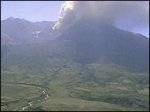Volcanoes
Volcanic gases that pose the greatest potential hazards are sulfur dioxide, carbon dioxide, and hydrogen fluoride. Locally, sulfur dioxide gas can lead to acid rain and air pollution downwind from a volcano. These gases can come from lava flows as well as a volcano that erupts violently.
Volcanic ash can travel hundreds to thousands of miles downwind from a volcano. Fresh volcanic ash is gritty, abrasive, sometimes corrosive, and always unpleasant. Although ash is not highly toxic, it can trouble infants, the elderly, and those with respiratory ailments. Ash can also get in your eyes and scratch them, especially when it's windy. Ash can be hazardous to grazing livestock and can damage or force the shutdown of drinking water and wastewater treatment facilities by clogging or damaging equipment.
General preparation and recovery
Health issues
Environmental impacts
Related links
How does EPA respond
to volcano eruptions?
In its mission to protect human health and the environment, EPA may be involved in the monitoring of environmental conditions, assessing potential health impacts, or responding to hazardous materials emergencies that may arise as a result of an eruption.
Human Health Impacts - EPA has considerable expertise on the potential health impacts from ash or chemicals released from volcanoes. Toxicologists and other specialists may be needed to evaluate environmental conditions and effects on populations surrounding the mountain.
Emergency Response - EPA may be called upon to provide support to initial responders to an eruption event.
For example, in the fall of 2004 a Unified Command was established for Mount St. Helens which was then showing increased activity. The Command included the U.S. Forest Service (lead agency), U.S. Geological Survey, and state and local authorities. EPA joined the Unified Command in an advisory and support role, and was prepared to provide support with GIS mapping and analysis, air and water monitoring and modeling, and other services to aid in the overall response.
General preparation and recovery
- US Geologic Survey
- National Oceanic and Atmospheric Administration
- Current
Volcanic Ash Advisories - updated in real time, for the US and for other countries, plus historical advisories going back several years.
- Current
Volcanic Ash Advisories - updated in real time, for the US and for other countries, plus historical advisories going back several years.
- Federal Emergency Management Agency
- American Red Cross
- Volcano - be prepared for the hazards
- Preparedness
Information - general information on being prepared
For water and wastewater facilities - Suggested activities to help facilities prepare for severe conditions. Please note, this information is written for hurricane preparedness but much of it will apply to any type of preparedness or recovery.
More links for disaster preparedness or response.
Health issues
- Health impacts (USGS)
- Volcanoes can impact air quality
- Particle pollution and your health
- Air Quality Guide for Particle Pollution
- Air Quality Guide for Sulfur Dioxide
Environmental effects
- Waste water - preparation and response for water treatment facilities
- Related Information From Other Agencies
 :
:
Related links
- US EPA Region 10: The
Pacific Northwest
Washington, Oregon, Idaho, Alaska and Native Tribes - Oregon Department of Environmental
Quality

- Washington Department of Natural
Resources

- Power Outages & Food Safety, US Department of Agriculture
- Tephra: Volcanic Rock and Glass Fragments (volcanic ash)
- Volcanic Gases and Their Effects
- Types and Effects of Volcano Hazards
- Mount St. Helens
National Volcanic Monument

- Myth: Volcanoes and the Oceans are Causing Ozone Depletion
![[logo] US EPA](https://webarchive.library.unt.edu/eot2008/20090117174101im_/http://www.epa.gov/epafiles/images/logo_epaseal.gif)
